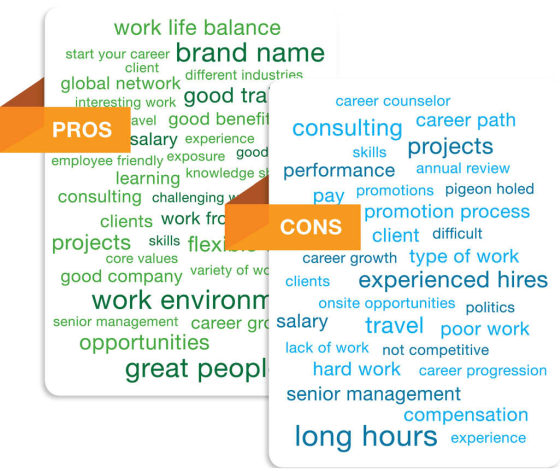Yesterday’s Advisor featured tips from Employer Branding for Dummies, by Alicia Garibaldi (published by John Wiley & Sons). Garibaldi recommends a reputation word cloud (see example below) to highlight positive and negative perceptions of your company.
 |
Knowing your company’s key strengths and weaknesses can help you build your employer brand. When you look at your company’s word clouds, take note of what people like most—and least—about your company. This information identifies areas that you need to work on so that you can enhance your appeal to candidates.

Source: Employer Branding for Dummies
Big Picture Questions
Start with “Big Picture” questions, says Garibaldi:
- Is your current employer brand helping or hurting your recruiting and retention?
- What is my brand awareness with jobseekers?
- Who does my brand attract and are they who I want?
- What’s my brand reputation?
- How does my awareness and reputation stack up versus the competition?
Tracking Competitors’ Brand Performance
The best way to start analyzing your competition is to compare the traffic on your competitors’ career pages with traffic on yours. Sites such as Glassdoor offer tools that help you do just that, says Employer Branding. Garibaldi offers a four-step process:
- Compare candidate visits each month. Find out how many jobseekers are visiting competitors’ pages compared with yours.
- Identify candidate demographics. Find out candidate genders, current job titles, and locations.
- Compare company ratings. See how other companies rate in key areas, such as work/life balance and leadership.
- Identify the channels your competitors use to reach talent. This information can help you ensure that your employer brand is featured wherever candidates are making career decisions.
Some other actions recommended by Employer Branding for Dummies:
Monitor Your Reputation
It’s important to monitor your reputation online, and it’s helpful to do it regularly so you can identify patterns and trends. Garibaldi, using Glassdoor data as an example, suggests monitoring candidate views on:
- Culture and values
- Work/life balance
- Senior management (what employees think of the leadership in place)
- Compensation and benefits
- Career opportunities
Is your onboarding truly getting new employees what they need to succeed? Find out on October 28, 2014 with a free interactive webcast Onboarding: Engaging New Hires Early and Often. Learn More
Get Feedback on the Candidate Experience
Garibaldi notes that job applicants’ comments on the interviewing process give you first impressions of your employer brand, such as whether a candidate thought the interview was a positive, neutral, or negative experience. Some sites also provide difficulty ratings for interviews.
Ask candidates how they found out about your job, what made them apply, and what method they used to apply. You can also check interview reviews of your competitors’ processes on a site like Glassdoor, suggests Garibaldi. That may help you refine your own recruiting efforts.
Job Candidates’ Online Activity and Preferences
Sites such as Glassdoor allow you to analyze what job titles are most clicked and where job activity is coming from. Your applicant tracking system (ATS) should then be able to close the loop and break down applicants by source. These data enable you to measure success and determine the quality of hire and cost per hire for each recruiting channel.
A big part of employment branding is making sure you have an onboarding program that really welcomes new employees and gets them introduced to the organization in a meaningful way.
Unfortunately, although organizations pay lots of attention to successfully recruiting new hires, they often don’t follow through with the critical processes by which these new hires learn the skills and behaviors needed to function effectively at their jobs.
The bottom line, however, is that the faster new hires feel welcome and prepared for their work, the faster they will be able to successfully contribute to the organization’s mission. Conversely, so-called “quick quits,” or when employees leave within the first 90 days, and early turnover, when employees leave within the first year, are extremely expensive problems for organizations.
Good news—here’s help, in the form of a free new webcast—Onboarding: Engaging New Hires Early and Often. In just 60 minutes, you’ll learn everything you need to know about onboarding.
Register today for this free (thanks to sponsor SilkRoad) interactive webinar.
Onboarding program weak? Learn how to beef it up. Join us October 28 for a free interactive webcast Onboarding: Engaging New Hires Early and Often. Earn 1 hour in HRCI Recertification Credit. Register Now
In this informative Q and A webinar:
Expert Lisa Rowan of IDC (see bio below) will discuss the keys to effective onboarding and its importance to any organization by answering the following onboarding questions:
- What makes onboarding an executive-level issue and a challenge to company strategy?
- What does good onboarding look like? What about bad? And when should an executive get involved?
- What should executives and HR leaders do to ensure onboarding success?
- What solutions are available to help organizations onboard more effectively?
Join us for this informative webinar that offers sound advice on assessing your company’s onboarding approach and how you can make it one of your strongest competitive advantages!
Register now for this webcast.
Tuesday, October 28, 2014
2:00 p.m. (Eastern)
1:00 p.m. (Central)
12:00 p.m. (Mountain)
11:00 a.m. (Pacific)
Approved for Recertification Credit
This program has been approved for 1 recertification credit hour toward recertification through the Human Resource Certification Institute (HRCI).
Join us on October 28 for the free, in-depth Onboarding: Engaging New Hires Early and Often webcast.

About Your Presenter:
Lisa Rowan serves as IDC’s Research Vice President, HR and Talent Management Services research. In this role, Ms. Rowan provides expert analysis focused on both the business services and software used to address HR and talent-related processes. Her research encompasses human capital applications, human resource consulting, HR processing services and HR Business Process Outsourcing (BPO)services.
